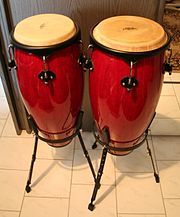
Back سالسا (موسيقى) Arabic سالسا (موسيقى) ARZ Salsa (música) Catalan Salsa (musik) Danish Salsa (Musik) German Σάλσα (μουσική) Greek Salso Esperanto Salsa (género musical) Spanish Saltsa (musika generoa) Basque سالسا (موسیقی) Persian
| Salsa | |
|---|---|
| Stylistic origins | |
| Cultural origins | Puerto Rican and Cuban communities in the United States, specifically in New York City[1][8][9] |
| Subgenres | |
| Regional scenes | |
| Other topics | |

Salsa music is a style of Latin American music, combining elements of Cuban, Puerto Rican, and American influences. Because most of the basic musical components predate the labeling of salsa, there have been many controversies regarding its origin. Most songs considered as salsa are primarily based on son montuno and son Cubano,[10] with elements of cha-cha-chá, bolero, rumba, mambo, jazz, R&B, bomba, and plena.[11] All of these elements are adapted to fit the basic Son montuno template when performed within the context of salsa.[12]
Originally the name salsa was used to label commercially several styles of Hispanic Caribbean music, but nowadays it is considered a musical style on its own and one of the staples of Hispanic American culture.[13][14]
While the term salsa today is a rebranding of various Latin musical styles, the first self-identified salsa band is Cheo Marquetti y su Conjunto - Los Salseros which was formed in 1955.[15] The first album to mention Salsa on its cover was titled “Salsa” which was released by La Sonora Habanera in 1957. Later on self-identified salsa bands were predominantly assembled by Puerto Rican and Cuban musicians in New York City in the 1970s. The music style was based on the late son montuno of Arsenio Rodríguez, Conjunto Chappottín and Roberto Faz. These musicians included Celia Cruz, Willie Colón, Rubén Blades, Johnny Pacheco, Machito and Héctor Lavoe.[16][17] During the same period a parallel modernization of Cuban son was being developed by Los Van Van, Irakere, NG La Banda, Charanga Habanera and other artists in Cuba under the name of songo and timba, styles that at present are also labelled as salsa. Though limited by an embargo, the continuous cultural exchange between salsa-related musicians inside and outside of Cuba is undeniable.[18]
- ^ a b Waxer 2002, pp. 91–94
- ^ Gerard 1989, pp. 8–9.
- ^ Salazar, Max (January 26, 1985). "Salsa Losing Popularity To Ballads On City Airwaves". Billboard. Vol. 97, no. 4. p. 58. ISSN 0006-2510.
- ^ Salazar, Max (2001). Vladimir Bogdanov; Chris Woodstra; Stephen Thomas Erlewine (eds.). All Music Guide: World Music (4th ed.). Hal Leonard Corporation. p. 884. ISBN 978-0-87930-627-4.
- ^ Catapano 2011. "Although a great number of New York's stars and sidemen in the 1970s were Cuban and Puerto Rican, the basic musical elements of salsa were derived mainly from Cuba."
- ^ Morales 2003, p. 33. Morales writes that "While many Afro-Cuban music purists continue to claim that salsa is a mere variation on Cuba's musical heritage, the hybridizing experience the music went through in New York from the 1920s on incorporated influences from many different branches of the Latin American tradition, and later from jazz, R&B, and even rock." Morales' claim is confirmed by Unterberger's and Steward's analysis.
- ^ Mauleón 1993, p. 215. Mauleón codifies this approach with examples of bomba, plena, and merengue arrangements for the salsa ensembles. When adapting these non-Cuban rhythms to salsa it is common to alter them in order to fit into the Cuban template. For example, Mauleón's merengue chart includes clave, which is essential to Cuban popular music, although it is not a component of the traditional Dominican rhythm.
- ^ Salazar, Max (January 26, 1985). "Salsa Losing Popularity To Ballads On City Airwaves". Billboard. Vol. 97, no. 4. p. 58. ISSN 0006-2510.
- ^ Salazar, Max (2001). Vladimir Bogdanov; Chris Woodstra; Stephen Thomas Erlewine (eds.). All Music Guide: World Music (4th ed.). Hal Leonard Corporation. p. 884. ISBN 978-0-87930-627-4.
- ^ Catapano 2011. "Although a great number of New York's stars and sidemen in the 1970s were Cuban and Puerto Rican, the basic musical elements of salsa were derived mainly from Cuba."
- ^ Morales 2003, p. 33. Morales writes that "While many Afro-Cuban music purists continue to claim that salsa is a mere variation on Cuba's musical heritage, the hybridizing experience the music went through in New York from the 1920s on incorporated influences from many different branches of the Latin American tradition, and later from jazz, R&B, and even rock." Morales' claim is confirmed by Unterberger's and Steward's analysis.
- ^ Mauleón 1993, p. 215. Mauleón codifies this approach with examples of bomba, plena, and merengue arrangements for the salsa ensembles. When adapting these non-Cuban rhythms to salsa it is common to alter them in order to fit into the Cuban template. For example, Mauleón's merengue chart includes clave, which is essential to Cuban popular music, although it is not a component of the traditional Dominican rhythm.
- ^ Gerard 1989, pp. 8–9. "From jazz came a harmonic vocabulary based on extended harmonies of altered and unaltered ninths, elevenths and thirteenths, as well as quartal harmony—chords built on fourths. These harmonic devices entered salsa in the piano styles of Eddie Palmieri and the Puerto Rican Papo Lucca. They would take traditional piano figures based on simple tonic-dominant harmony and elaborate them with modern harmonies. These modern harmonies are now a staple of salsa arrangers such as Marty Sheller and Óscar Hernández."
- ^ "Origins of Salsa Music". Pimsleur.com. 28 November 2018.
- ^ "Salsa y sabor de Cheo Marquetti y Su Conjunto los Salseros, 33 1/3 RPM con cdandlp".
- ^ Boggs 1992, pp. 187-193
- ^ Hutchinson 2004, p. 116. Hutchinson says salsa music and dance "both originated with Cuban rhythms that were brought to New York and adopted, adapted, reformulated, and made new by the Puerto Ricans living there."
- ^ Unterberger, p. 50